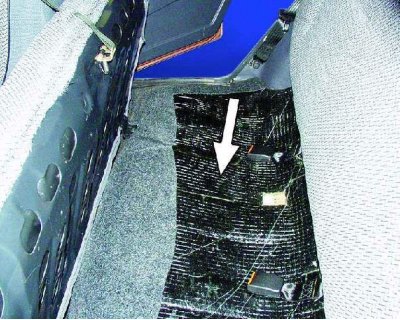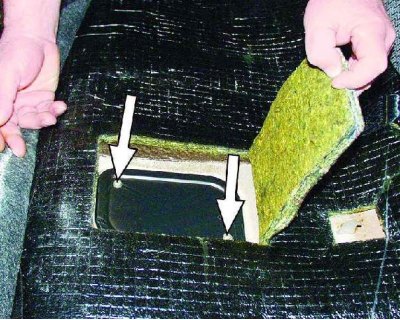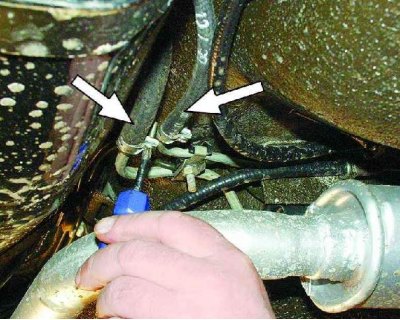
1 - fuel tank
2 - drain fuel line
3 - fuel supply line

1 - air release hose
2 - separator hose
3 - inlet pipe hose
Attention! Before starting work, disconnect the wire from the terminal "–" battery.
Note. It is recommended to remove the fuel tank with an assistant.

1. Fold back the rear seat cushion and unscrew the cut-out part of the noise insulation.

2. Loosen the two screws securing the sunroof cover.

3. Remove the manhole cover with rubber gasket.

4. Disconnect the wiring harness from the fuel level sensor.

5. Unscrew the sensor mounting nut, under which the wire is fixed "masses".

6. Remove the wire from the stud. The remaining operations are carried out under the bottom of the car.

7. Loosen the clamp.

8. Disconnect the hose from the fill pipe.

9. Loosen the clamp and disconnect the air outlet hose from the fitting on the fuel tank.

10. Loosen the clamp and disconnect the separator hose from the fitting on the fuel tank.

11. Loosen the clamps and disconnect the hoses from the fuel lines.

12. While holding the tank, unscrew the two bolts of the tank fastening clamps.

13. Pull the clamps down while supporting the tank. Bend the clamp on the left side behind the resonator tube.

14. Lower the front end of the tank down and remove it from the vehicle. Drain the remaining gasoline from the tank.

15. Remove the five remaining sensor mounting nuts and remove the fuel gauge sensor from the tank.

Fuel gauge sensor: 1 - mesh filter; 2 - float; 3 – sensor body; 4 - connecting block

16. Remove the sensor gasket.

17. Inspect the tank along the junction of the upper and lower parts. If you find a leak, pour out the remaining gasoline, rinse thoroughly and dry the tank. Then solder the leak with soft solder. If necessary, glue the torn off rubber gaskets on the tank.
Warnings:
- You can only solder a thoroughly washed tank that does not contain gasoline vapors. Otherwise, the fumes may ignite during soldering.
- To flush the fuel tank, use detergents: "Labomid", "MS" or "ML". To remove detergent residue, rinse and steam the tank with hot water. Dry the tank thoroughly.

18. Connect an ohmmeter to the sensor terminals and check the resistance of the sensor at three positions of the float. In the lowest position (empty tank) resistance should be 315-345 ohms, in the middle position (tank half full) - 108-128 ohms, in the highest position (full tank) - no more than 7 ohms. If the resistance is not as specified, replace the sensor.

19. Wash the dirty filter. Shake the float. If there is gasoline in it, then the float is leaking. We recommend replacing the float.

20. To replace the tank clamps, remove them from the brackets on the body and install new ones.

21. Assemble and install the fuel tank in reverse order. Before installing the tank, remove the wires of the fuel level sensor inside the body.
